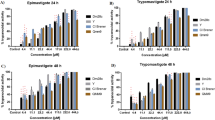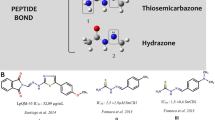Abstract
WE have long been looking for an antagonist of arsenicals and antimonials to decrease selectively their toxic action, without interfering with their therapeutic effectiveness. The dimercaptans behave in the opposite way: for example, 2,3-dimereaptopropanol (BAL), in one-eighth of the dose of ‘Arsenoxide’ employed, abolishes anti-trypanosomal activity, and only multiple doses of toxic arsenic can act as antidote1. Having observed BAL to abolish the activity of penicillin and chloromycetin in spirochaete infections without affecting antistreptococcal activity2, we realized that selective antagonism against particular cells, which could be host cells, is possible. We found that ‘Penicillamine’ (dimethylcysteine, DMC) whiuh is known to detoxify bivalent heavy metals (mercury, lead)3–5 is also a powerful antidote against arsenicals and antimonials, which does not interfere, within a wide range, with their antiparasitic effectiveness in vivo and in vitro.
This is a preview of subscription content, access via your institution
Access options
Subscribe to this journal
Receive 51 print issues and online access
$199.00 per year
only $3.90 per issue
Buy this article
- Purchase on Springer Link
- Instant access to full article PDF
Prices may be subject to local taxes which are calculated during checkout
Similar content being viewed by others
References
Ercoli, N., and Wilson, W. J., Pharmacol. Exp. Therap., 92, 121 (1948).
Ercoli, N., Gosford, B., Carminati, G. M., Kley, D., and Schwartz, B. S., Proc. Soc. Exp. Biol. and Med., 78, 253 (1951).
Boulding, J. E., and Baker, R. A., Lancet, ii, 985 (1957).
Aposhian, H. V., Science, 128, 93 (1958).
Aposhian, H. V., Fed. Proc., 20, Suppl. 10, 185 (1961).
Ercoli, N., and Tabernero, E., Fed. Proc., Abstract, 25, 556 (1966).
Chen, G., Geilling, E. M. K., and MacHatton, R. M., J. Infect. Dis., 76, 152 (1945).
Ron Pedrique, M., Chacin Lander, C., Sanson, R. E., and Arroyo, J. M., Acta Médica Venezolana, 14, 137 (1967).
Liang, Y., Chu, C. C., Tsen, Y. L., and Ting, K. S., Acta Physiol. Sinica, 21, 24 (1957).
Author information
Authors and Affiliations
Rights and permissions
About this article
Cite this article
ERCOLI, N. Selective Antagonism of Arsenicals and Antimonials. Nature 216, 398–399 (1967). https://doi.org/10.1038/216398a0
Received:
Revised:
Published:
Issue Date:
DOI: https://doi.org/10.1038/216398a0
Comments
By submitting a comment you agree to abide by our Terms and Community Guidelines. If you find something abusive or that does not comply with our terms or guidelines please flag it as inappropriate.



